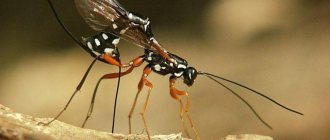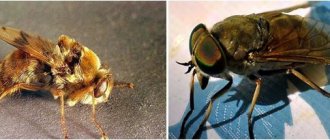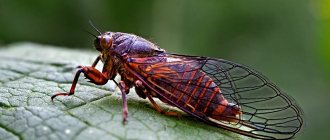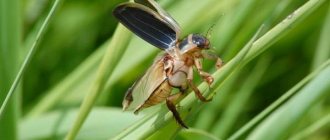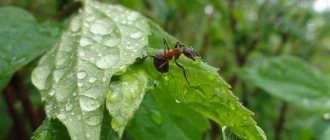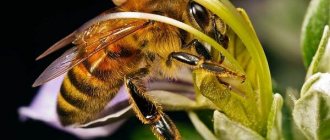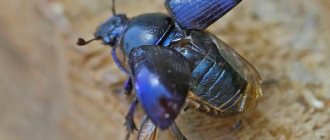Description and features
People for the most part do not like insects and treat them with arrogant disgust. Of course, compared to us, the highly developed inhabitants of the planet, at first glance they seem primitive, unpleasant, often annoying, and sometimes even downright disgusting. But still, the world of insects is a whole universe of amazing creatures worthy of the pen of a science fiction writer.
After all, each of these creatures has its own unique abilities. For example, the hero of our story, the insect rider, is endowed by nature with the interesting property of turning its own kind, that is, representatives of the class of insects and other arthropods, into real zombies. We have to find out how this happens and why riders need it.
Such creatures can be very small, barely noticeable, less than 1 mm in size. But there are also huge varieties in comparison with babies, reaching a length of up to 5 cm. In appearance, equestrians are very diverse. At a superficial glance at representatives of individual species, you can mistake them for ordinary beetles.
In fact, these are more likely wasps, and even look similar to them, but instead of a sting on the back, they have a very noticeable ovipositor, pointed at the end, often comparable in size, and sometimes even larger (in special cases 7.5 times ) of the insects themselves, but in some cases very tiny.
With the help of this organ, these creatures place eggs in the bodies of their victims, and only in this way are they able to exist, develop and continue their race. Ultimately, the life activity of equestrians most often turns out to be useful for humans.
Although, in fact, for arthropods they are very dangerous parasites, and therefore they are often called parasitic wasps. According to the systematization of living organisms, they belong to the stalked bellies. This order includes the same wasps, as well as bumblebees, bees, and ants. And therefore it turns out that these are the closest relatives of the riders.
The body of the described creatures is elongated in shape and is supported by six thin legs. These insects have a small head, equipped with long antennae extended forward like antennae.
These devices help them recognize their surroundings. The riders are hymenoptera , and therefore representatives of most species have membranous, elongated, transparent wings with a brown or grayish tint, mottled with veins. But there are also wingless varieties, which are very reminiscent of ants.
Other riders, due to the abundance of different colors inherent in them, are often confused with related bees, as well as with a number of other insects. Riders come in bright red, orange, spotted, and striped colors. But the most common body color is predominantly black, complemented by bright, different shades of transitions.
Mistaking ichneumon wasps for wasps, people are often frightened by their huge ovipositor, believing that it is a terrifying sting that is poisonous to humans. But this opinion is wrong. By the way, only females have this terrible organ, and the male half is naturally deprived of it, as well as, of course, the ability to lay eggs.
What do beneficial parasites usually eat?
Most species of such insects do not eat meat. The adult rider (insect) eats the nectar of flowers and hunts to continue its lineage. There are mature individuals that do not feed on anything at all. However, parasites are very fond of drinking, gathering near lakes and feasting on dew. They exist for no more than 2 months, some of them are evening or nocturnal insects. But at the same time, the favorite and main food of riders are:
- mealybugs;
- cicadas;
- sawflies;
- scale insects;
- aphid;
- bedbugs;
- pest butterflies;
- flies;
- whiteflies;
- burners;
- beetles;
- blood aphid.
Many will be interested to hear the answer to the question: “Is the insect rider dangerous for humans?” Absolutely not, and on the contrary, these parasites play an important role in nature, protecting garden plots with fruit trees and vegetables from the invasion of various pests.
Kinds
The species diversity of such parasites is truly enormous. There are more than a dozen superfamilies into which they are united. species of riders themselves amounts to hundreds of thousands. It is impossible to describe them all, so it is better to talk in general terms about some of the most common or distinctive groups of these insects.
Representatives of the chalcid superfamily are quite small, in some cases even microscopic in size. Some species are so tiny that they cannot be seen with the naked eye. And it’s not surprising, because the length of especially small ones does not exceed 0.2 mm.
Their color varies. But all varieties (it is assumed that there are about half a million of them in nature, although only 22,000 of them have been truly described by biologists) have one common feature: the structure of the wings, which have only two veins. From a scientific point of view, such creatures are interesting because they parasitize not only small representatives of the fauna, but also plants.
The chalcid superfamily is in turn divided into families, some of which will be listed below. It should be noted that they themselves include many varieties.
- Leucopids in color, black with yellow stripes and spots, and body shape with an elongated, convex abdomen, are very similar to wasps, which, by the way, they parasitize. Their antennae are short, but placed on a large head. Such creatures are quite noticeable to the eye, on average about 7 mm. Also parasitizing bees, these riders harm apiaries.
- On the contrary, aphelinids turn out to be very useful because they destroy aphids and scale insects. They rarely exceed 5 mm in size. These creatures have powerful jaws, a narrowed head, and small fringed wings.
- The agonids are comparable in size to the previous group. In males of certain species, underdevelopment of wings and one of the three pairs of legs is observed. These are plant parasites that place their eggs in figs.
- Trichogrammatids are millimeter-long babies. This group is very useful, as it destroys agricultural pests, in particular codling moths and cabbage moths, in addition – bedbugs, dragonflies, butterflies, and beetles.
- Aphelinus. This is the name of a genus of fairly large representatives from the aphelinid family. These creatures have a black color, in some cases with a yellow pattern. The sizes of such riders are on average centimeter. Due to their benefits for garden crops, these insects were deliberately brought to Europe from America. Destroy blood aphids and other pests. The single egg they lay in their prey turns it into a dried-out mummy as it grows.
- Plum seed eater, about 3 mm in size. Its body is green, its antennae and legs are yellow. The name itself suggests that such creatures are garden pests. In addition to plums, they infect the seeds of apple and pear trees.
- The plum beetle is a black insect with yellow legs, about 5 mm in size. Lays eggs in plums, apricots, cherries, and very often in cherry plums and almonds, thereby destroying them. The wings of these creatures have not even two, but one vein.
Now let's introduce some members of other superfamilies. Without a doubt, they are numerous and varied, like the entire world of insects. Most of these riders are useful. They help many plants and free the environment from pests.
- Rissa is a black ichneumon, but with yellow stripes on the abdomen, and has a huge ovipositor. This is a forest orderly that kills wood pests: horntails, beetles, longhorned beetles and others. It detects its victims by smell, and its larvae eat their internal organs.
- Panisk looks like a huge black mosquito with red legs. Protects grain crops by parasitizing their pests. In addition, it infects moth caterpillars with its eggs.
- The Ephialtes Emperor is a gigantic specimen of an equestrian, of course in comparison with its smaller relatives. Its body reaches a size of 3 cm, but the size of the ovipositor is even larger. He himself has an elongated dark red abdomen, a black body and red legs. Destroys wood pests.
It is possible to systematize equestrians not only by species and families. As parasites, they are grouped according to how they infect their victims. Here it should be taken into account that it is not the adults who are afraid of the victims.
The attackers do not directly take part in the destruction, but only their eggs, which develop inside and outside the so-called hosts and feed on them. And therefore we can distinguish the following groups of riders, without exception, all species of which are parasites:
- ectoparasites attach their clutches to the outside of the victim’s body or simply leave them close to its eggs, and infect mainly pests hiding deep inside trees and fruits;
- endoparasites make their clutches in the internal tissues of the victim, their larvae develop longer than those of the previous group, but as they grow, they most often leave only an external, surrounding void, shell with the hosts; all the insides are eaten.
Ageniaspis
Considered one of the original designs. The parasite (insect) specializes in infecting the apple moth egg, however, it does not mature for a long time, but waits for the caterpillar itself to develop. Then from this egg many twins appear. From the eaten larvae, 150-200 ageniaspis are hatched.
The record holder for fertility is plastigaster. It mainly parasitizes the Hessian grain fly. The female infects both young larvae and eggs, laying up to 3000 eggs during her life.
No less popular is encarsia, which lays its eggs on the larvae of the greenhouse whitefly. Almost all greenhouse agricultural companies propagate it.
Lifestyle and habitat
It is no coincidence that the described creature received the nickname “ rider ”. By placing their eggs, these insects seem to saddle their victims, taking a pose above them. The entire life of an adult is subordinated to the desire to continue its race, and therefore represents an endless search for suitable carriers (owners) who raise and feed their offspring, although not of their own free will.
Adults are mainly active at night. In warm months, they tend to stay in sparsely populated places, close to water bodies, often occupying areas among flowering grasses, where there are more suitable insects - potential prey. But still, the environment of equestrians largely depends on the location of the distribution of carriers on which this species parasitizes.
If representatives of any species have an ovipositor of impressive size or the most intricate shape, then this is far from accidental. This means that such a device is necessary to, for example, pierce a thick layer of tree bark where a beetle larva is deeply buried from prying eyes. In this case, the rider's organ turns into a real drilling rig, equipped with a sharp drill. This sting is later pierced into the chosen victim.
Riders cope with sedentary organisms without much difficulty; they are not able to actively resist. But with some it is more difficult, because sometimes even large spiders and scorpions become targets of attack. In such cases, riders have to use their courage, dexterity and even sometimes ingenuity.
However, for such cases, nature has endowed these parasites with special abilities. Sometimes, to subdue the target of attack, a significant proportion of paralyzing poison is simply injected. In some cases, the riders practically hypnotize their victims and thus control and direct their actions.
When infecting moth caterpillars, some species of moths place their eggs in their internal tissues. Then the larvae develop there, eating the nutrient liquid, and when they grow, they get out and are caught on the skin.
What is shocking is that when the parasites, trying to pupate, leave the host’s body and spin their cocoon, attaching it to branches or leaves, the zombified caterpillar does not happily crawl away, but remains with its tormentors in order to protect them from the attacks of predators.
She becomes a zealous bodyguard, risking her own life by attacking stink bugs and other very dangerous insects. Why the caterpillars do this, and how the riders so subordinate their will to their interests, is not fully understood.
But it is largely due to zombie victims that riders manage to successfully survive and spread. Wherever the ichneumon lives , such insects successfully exist all over the world, take root in many environments and everywhere they find hosts through which they reproduce.
Aphelinus, aphidiid, aphidius
They are small parasitic parasites mainly on aphids. When an insect detects an aphid, it tucks its abdomen between its legs, quickly pierces it with its ovipositor and jumps away so that it does not spray it with the protective secretions of its tubes. Aphelinus lay only 1 egg in aphids. Their larvae form in it, and over time it turns into a mummy.
Nutrition
The terrible methods of feeding the larvae of such creatures are already clear. By the time they hatch from the eggs and begin to develop, their parents have already made sure that they have enough food. After all, organisms infected with them do not suffer significantly immediately. They not only live, but grow, develop and feed, at first little noticing that a parasite is brewing inside them. But over time, a terrible fate awaits them.
For example, larvae from the braconid family, specializing in caterpillars, by the end of their formation leave only the skin of it, completely eating all the insides of their host. At first, developing parasites consume only fat, causing little damage to the host, but then vital organs are used.
One way or another, absolutely all species of equestrians are parasitic. But it is interesting that adults in some cases do not eat anything at all. However, others still need food. In this case, the rider feeds either on the secretions of other insects, or on nectar or pollen of plants.
Eulophus
Such a parasitic ichneumon is an external group insect of the winter moth caterpillars, some specimens of butterflies, the ancient moth, leaf rollers, cutworms, moth moths, fruit moths, and others. At different periods, the death of winter moth caterpillars was noted at 27-37% from this parasite.
The size of an adult eulophus is no more than 2 mm. His body is silver in color. The ichneumon pupae overwinter in groups near the remains of the larvae, on fallen leaves, and rarely in the surface layer of soil under wood.
Beneficial ichneumon insects fly out of cocoons after overwintering, in the second half of May, at the stage of mass flowering of cherries, pears, mid-season varieties of currants, apple trees, cherries and plums. The flight of the parasite lasts approximately 2 weeks and ends at the beginning of the summer season. Eulophus are fed with nectar from weeds and flowers of fruit crops in garden plots. Since the winter moth caterpillars are absent from the garden at this time, the insects look for the larvae of other pests (leaf rollers, cutworms) and infect them.
By August, the larvae of the new generation have already finished feeding, pupate, firmly attaching themselves to the leaf, and after leaf fall ends, they move to the winter hut in fallen leaves or make their way into the surface layer of the earth.
Reproduction and lifespan
Having reached adulthood, riders do not live long, usually no more than three months. And only in cases when, during the period of completion of formation, they are caught by cold weather, they go into forced wintering, and in the spring they complete their life cycle and die. In this case, their lifespan can be up to ten months. Each species approaches reproduction individually.
After mating, the female ephialtes ichneumon has to look for a suitable longhorned beetle larva in the bark of a tree. To do this, she runs along the trunk and taps everywhere with her antennae. Based on this sound, it detects the location of the object.
Next, she drills into the wood with her ovipositor, standing on her hind legs, spinning it like a top. This work lasts at least two hours. When it reaches the larva hidden in the trunk, the parasite places a single egg inside it.
The number of eggs of small species from the braconid family reaches 20 pieces. They paralyze the caterpillars, which are their main carriers, with poison. Not even a day passes after the attack before the larvae appear.
They complete all stages of formation in five days, and pupation lasts another four days. But developing rapidly, such creatures live extremely short lives: males - no more than 10 days, and the female half - only a month.
Large braconids can infect ladybugs by placing an egg inside. In this case, facial development occurs more slowly, sometimes more than three weeks. It feeds on the connective and fatty tissues of the cow.
And at a certain time it leaves the body, but not the victim. In this case, the larva gnaws the motor nerves and paralyzes the cow. Then a cocoon is formed under it. Thus, about a week passes in the pupal stage, and then the tormentor leaves forever for adulthood.
Groups of riders
There are several groups of riders, differing in their methods of parasitism:
- Ectoparasites most often infect victims living inside fruits or wood, they paralyze the victim and attach eggs to the outside;
- Endoparasites inject their eggs directly into the victim; in endoparasite larvae, development takes longer;
- Superparasites or parasite parasites infect other species of Hymenoptera and Diptera parasites.
The infraorder ichneumonids includes a huge number of species and subspecies of insects.
Benefits and harms
The rider in the photo looks unusual and curious, and you immediately want to take a closer look at him. Despite the considerable harm these creatures cause to beneficial arthropods and some cultivated plants, their positive contribution to the ecosystem is obvious. One has only to say that numerous squads of these creatures destroy up to 80% of pests.
And therefore, some of the varieties are even taken under human protection, moreover, they are deliberately distributed. This is also good because business owners do not have to use chemicals and poisonous drugs to persecute harmful insects - their carriers. At the same time, both the environment and the harvest are preserved. And such benefits are brought by an insect that, at first glance, is incapable of arousing any sympathy.
Often, riders are bred in grain warehouses, destroying barn pests. In some cases, they are able to infect food products with their eggs, which of course causes losses, but in essence they are insignificant.
Panisk
These are large parasitic insects. The riders look like huge red mosquitoes, they fly into the light of a lamp and are distinguished by short ovipositors. 40 species of nocturnal moths parasitize caterpillars, including winter worms and cutworms, which cause considerable damage to winter crop plantings. They attach 3 eggs to the back of the caterpillars, and the larvae soon hatch from them and press tightly against the pests until the period when they need to weave a pupa and pupate.
Bibliography
- Centers for Disease Control and Prevention. Brucellosis. Parasites. Link
- Corbel MJ Parasitic diseases // World Health Organization. Link
- Young EJ Best matches for intestinal parasites // Clinical Infectious Diseases. — 1995. Vol. 21. - P. 283-290. Link
- Yushchuk N.D., Vengerov Yu.A. Infectious diseases: textbook. — 2nd edition. - M.: Medicine, 2003. - 544 p.
- Prevalence of parasitic diseases among the population, 2009 / Kokolova L. M., Reshetnikov A. D., Platonov T. A., Verkhovtseva L. A.
- Helminths of domestic carnivores of the Voronezh region, 2011 / Nikulin P. I., Romashov B. V.
An article for patients with a doctor-diagnosed disease. Does not replace a doctor's appointment and cannot be used for self-diagnosis.
The best stories from our readers
Topic: Parasites are to blame for all troubles!
To: Administration Noparasites.ru
Not long ago my health condition worsened. I began to feel constant fatigue, headaches, laziness and some kind of endless apathy appeared. Problems also appeared with the gastrointestinal tract: bloating, diarrhea, pain and bad breath.
I thought it was because of the hard work and hoped that it would go away on its own. But every day I felt worse. The doctors couldn’t really say anything either. Everything seems to be normal, but I feel like my body is not healthy.
I decided to go to a private clinic. Here I was advised, in addition to general tests, to get tested for parasites. So in one of the tests they found parasites in me. According to doctors, these were worms, which 90% of people have and almost everyone is infected, to a greater or lesser extent.
I was prescribed a course of antiparasitic medications. But it didn’t give me any results. A week later, a friend sent me a link to an article where some parasitologist shared real tips on fighting parasites. This article literally saved my life. I followed all the advice that was there and after a couple of days I felt much better!
Digestion improved, headaches went away and the vital energy that I so lacked appeared. To be sure, I took the tests again and no parasites were found!
Anyone who wants to cleanse their body of parasites, no matter what types of these creatures live in you, read this article, I’m 100% sure it will help you! Go to article>>>
Still have questions? Ask them in our Anonymous group on VK
How to get rid of parasites in a week. The answer is here!
A reliable and effective remedy for combating worms. Removes all parasites in 21 days.
Go to website
Reviews
Read online
Symptoms that 100% indicate parasites! Take the Test.
How to rid your body of life-threatening parasites before it’s too late!
Read more
Website
To get a consultation
The doctor tells how to quickly get rid of parasites for adults and children!
A parasitologist explains what effective methods exist to combat helminths.
More details
Read completely
Comments
Search for cures for parasites
Other tests
We recommend reading
Parasites of ciliates: description of representatives, danger to humans
03/29/202003/29/2020ecoliv94
Do lice jump on people's clean hair? Do they know how to fly?
08.03.202008.03.2020ecoliv94
Types of amoebas in humans: description, class, type and order, appearance and structure
03/07/202007.03.2020ecoliv94
Trichomonas Hominis in humans: description of the parasite, mating cycle, routes of infection
03/07/202007.03.2020ecoliv94
Care
The giant phalaenopsis is very demanding when it comes to indoor conditions.
Optimal conditions of detention
For good growth and normal flowering when kept indoors, it must be provided with favorable growing conditions:
- The optimal cultivation temperature is in the range of 22-30℃ with a mandatory daily temperature fluctuation of 5-8℃. The plant does not tolerate well if the room temperature drops below 15℃;
- Lots of diffused light, much more than most other orchid species. In winter, the orchid is placed on the brightest window, as it grows all year round;
- The required indoor air humidity is 60-85%. To maintain optimal humidity, you can use a humidifier or place the orchid pot on damp expanded clay;
- The plant loves good air circulation so that moisture quickly evaporates from the leaves.
If you create favorable conditions for the giant phalaenopsis, it will reward you with good growth and extraordinary flowering.
Here's another giant. Other photos and description of this specimen can be found here.
Advice! If the orchid is not growing well, pay attention to the lighting. The right location plays an important role in the health and well-being of the plant.
Replanting after purchase
After purchase, phalaenopsis is not recommended to be replanted. This can only be done if rotten roots are visible.
It is better to place the plant in diffused light, away from other indoor plants. At first, it is not recommended to water or feed it.
If no diseases are detected during quarantine, then after 10 days the plant can be placed in a permanent place and watered.
Watering and fertilizing
Like other types of orchids, giant phalaenopsis is very sensitive to watering:
- Water the phalaenopsis as the substrate dries. It is better to do this in the morning so that the water that remains on the leaves dries by the evening. Watering is carried out once every 7 days, and care is taken not to cause waterlogging of the substrate;
- To water, place the pot with the plant in a container filled with water to 2/3 of the height of the pot and leave to stand for 15 minutes. After the roots are saturated with water and have acquired a bright green color, the pot is placed on the surface for 30 minutes to allow the water to drain;
- A good outflow of water can be ensured by placing the pot at an angle of 35-40°;
- If there is insufficient lighting in winter, the regime of watering and feeding the orchid is reduced.
Attention! It is necessary to ensure that water does not accumulate at the growth point of the giant phalaenopsis, as this can lead to rotting of the orchid. Fertilizing is carried out with highly diluted fertilizer for orchids.
Fertilizing is carried out with highly diluted orchid fertilizer.
For phalaenopsis growing on different substrates, different types of fertilizers are used:
- On a substrate of living sphagnum moss, foliar feeding with fish fertilizer is used (0.1 teaspoon per 3.8 liters of water). In this case, you cannot use chemical fertilizers, this can lead to the death of the substrate;
- On a bark substrate, the plant is fed with ½-1/4 doses of orchid fertilizer.
Feeding is carried out during every third watering of phalaenopsis.
Stimulating flowering
To stimulate the flowering of giant phalaenopsis, the plant needs daily temperature fluctuations.
Optimal differences should not exceed 5-8 ℃: from 30-31 ℃ during the day to 22-23 ℃ at night.
Attention! The main condition for regular flowering of an orchid is optimal maintenance conditions and proper care.
Prevention of diseases and pests
In order for the orchid to grow healthy, it is necessary to ensure that water does not fall on the leaves when watering and does not stagnate in the leaf axils, as this can cause bacterial rot.
Rotting of the growing point is especially dangerous. To prevent this from happening:
- After watering, the water from the surface of the leaf must be blotted with a paper napkin;
- To prevent water from accumulating at the base of the leaves, it is better to place or hang the container for orchids at an angle of 40-45o.
On rainy days, after watering, you can spray the plant with a fungicide to prevent rotting.
Popular message topics
- Profession Nurse
A nurse (nurse) is a person with a secondary specialized medical education, a specialist in the field of nursing. This is a profession that is very difficult to underestimate, no doctor can handle it, - Environmental education
The relationship between man and the environment plays an important role in a favorable environmental situation on our planet. As a result of severe air and water pollution, life on earth is in danger of extinction. - Sharks
Man has been fascinated and interested in the sea and its inhabitants since ancient times. Many people liked the waves splashing on the shore and the beautiful blue water visible in the distance. Still, there were no such brave souls who agreed to go to the open sea,
Preventing an attack
The main prevention of a rider attack is considered to be careful behavior in nature. You should not come into contact with the parasite, try to catch it or kill it. When getting ready for a picnic or to a pond, you should wear thick clothes with long sleeves. It is better to treat children's skin with repellents, which will also protect the baby from bites of mosquitoes, other wasps, and midges.
Wasps are parasites that are harmless to humans and attack only insects. Fertilized females hunt for caterpillars, beetles or other wasps to lay their eggs. The hatched larvae are very voracious and can completely destroy the prey in just 5-6 days.
Brazilian wandering spider
Also known as Phoneutria, Brazilian wandering spiders are venomous creatures that live in tropical South America and Central America. In the 2010 Guinness Book of World Records, this type of spider was called the most poisonous spider in the world.
The venom of this genus of spiders contains a powerful neurotoxin known as PhTx3. In lethal concentrations, this neurotoxin causes loss of muscle control and breathing problems, leading to paralysis and eventual suffocation. The bite is of average pain, the venom causes immediate infection of the lymphatic system, entry into the bloodstream in 85% leads to heart failure. Patients feel wild rigor during life, sometimes causing priapism in men. There is an antidote that is used on par with antibiotics, but due to the severity of the damage to the body from the poison, the detoxification procedure is essentially equal to the victim's chance of survival.
Danger
The wasps are dangerous primarily for other arthropods, because parasitism leads to their death. This is the benefit of insects: they often fall prey to other pests that cause damage to human supplies, livestock, and agricultural crops. Equines, often being “super-parasites”, restrain the growth of their population. But is the ichneumon wasp dangerous for humans? The fear of these insects is not unfounded. Their body, like that of wasps, produces poison, so the bites do not go away without leaving a trace. But riders do not attack people just like that and do not lay eggs under human skin: they attack solely for the purpose of self-defense.
The poison is especially dangerous for those who have individual intolerance to the substances included in its composition. In this case, the bite can provoke a dangerous condition - anaphylactic shock. Even in the absence of hypersensitivity to the ichneumon ichneumon venom, soreness and swelling appear on the skin, which lasts for an average of three days.
Prevention from attacks by wasp wasps - careful behavior. If an insect is spotted nearby, there is no need to try to get to know it better or, on the contrary, actively drive it away with your hands. When visiting forests and meadows near water bodies, it is better to wear tight-fitting clothing that covers the entire body.
What to do if bitten by an ichneumon wasp? The action plan is universal for attacks by any insects:
But usually an encounter with an ichneumon wasp passes without any unpleasant consequences.
Riders are insects that are peaceful towards humans and never choose people as objects for parasitism. Their benefit lies in reducing the number of other pests. The only danger is their poisonous bite, which causes discomfort.
What to do if a wasp bites a person?
In some cases, hypersensitivity to the sting of a parasitic wasp wasp has been recorded. An allergic reaction occurs in young children and people with reduced immunity. To prevent anaphylactic shock or angioedema, it is recommended to provide first aid to the victim in a timely manner.
Symptoms and consequences
Most often, a wasp sting does not show up on the skin. But with a strong concentration of toxins that the insect injects during an attack, a slight redness appears. Itching and swelling may also occur. The most dangerous consequence of an encounter with a rider is considered to be scratching the wound. In this way, a person can independently introduce an infection. Symptoms of infection are swelling and tearing of the stung area, the formation of an abscess, and a rash.
If redness does not go away after 5 days, you should consult a doctor. To determine the diagnosis and prescribe treatment, the victim is given a referral for a scraping from the bite site, a general blood and urine test.
First aid
After a wasp attack, you should wipe the bite site with an antiseptic. Fukortsin, Miramistin, hydrogen peroxide or alcohol (vodka) are suitable for this. If pain occurs, you can take analgesics and antispasmodics. To prevent the development of swelling, redness and rashes, anti-inflammatory medications are needed.
Allergic reaction
An allergic reaction is rare because when a long-tailed wasp stings, it injects a minimal amount of toxin that is not dangerous to humans. But there is always a risk of developing severe swelling or hives. Young children need to be especially closely monitored. If signs of intolerance to poison appear, you should urgently take antihistamines (Suprastin, Loratadine, Zodak), and then seek help from a doctor.
Sources
- https://www.syl.ru/article/211515/new_naezdnik-nasekomoe-obschie-svedeniya-opisanie
- https://Dezoff.ru/nasekomye/osa-naezdnik/
- https://givnost.ru/naezdnik-nasekomoe-opisanie-osobennosti-vidy-obraz-zhizni-i-sreda-obitaniya-naezdnika/
- https://alternativa-mc.ru/infekcii-lechenie/osa-parazit-naezdnik.html
- https://GdeKlop.ru/osy-i-pchely/naezdnik-s-dlinnym-hvostom/
- https://klopkan.ru/osy/osa-naezdnik-foto-i-opisanie-opasna-li-dlya-cheloveka/
- https://kursi-floristiki.ru/klopy/osa-naezdnik.html
- https://givotniymir.ru/naezdnik-nasekomoe-obraz-zhizni-i-sreda-obitaniya-naezdnika/
- https://animalreader.ru/chto-za-nasekomyie-naezdniki-i-kak-oni-vyirashhivayut-potomstvo.html
- https://apest.ru/osy/vidy-os/osa-naezdnik/
[collapse]
The harmfulness of creatures
It's time to figure out whether the wasp is dangerous for people. No, rather the opposite - these insects bring considerable benefits to humans, ridding plantations of bark beetles, voracious caterpillars and spiders. Individuals help protect forests and agricultural lands, maintaining natural balance. Many homestead owners specifically attract creatures to their territory to combat harmful beetles and spiders.
Iridescent wasps are able to parasitize a huge number of pests, killing them and thus preventing damage to crops. Protecting food barns and agricultural fields with their help reduces the volume of toxic chemicals, which significantly improves the environmental situation.
It is worth remembering, however, that some species of ichneumon ichneumon bite quite painfully, but their bites pose a potential threat only to allergy sufferers and children.
Basically, this kind of damage does not pose a threat to humans and is completely harmless, so you can safely attract creatures to fight the annoying garden pests.
Fighting methods
In the garden or garden
- Pour boiling water over the area where insects accumulate;
- lay out the traps in the form of wet rags on which the two-tails will be collected, then destroy the traps;
- dig the area deeply in the fall, this will help reduce the number of unwanted guests next year;
- Earwigs are afraid of the smell of vinegar; you need to place sponges soaked in vinegar on the area for washing dishes.
Readers interested in earwigs may also find articles about the following pests useful: fruit flies, bedbugs, woodlice, nematodes, cicadas, mole crickets, Colorado potato beetles, dust mites, potato moths.
Common varieties
As already mentioned, there are many varieties of ichneumon wasps. In temperate climates, the most common superfamilies are:
- Mimarommatids, capable of living even in subantarctic zones and parasitizing insect eggs.
- Nutcrackers, which are both parasites and phytophages (feed on plant foods).
- Proctotroupoid riders with microscopic dimensions (body length - up to 5 mm). They are used as a biological agent in pest control.
- Chalcids, of which there are 200 species in Europe. Beneficial insects that destroy other harmful arthropods; and some of their species are involved in plant pollination.
- Evanioid riders, the abdomen of which is diagonally raised relative to the chest. They choose wasps, cockroaches, and sawflies as their victims.
The process of laying eggs
Such parasites are treasure hunters by nature. Distinguished by their excellent sense of smell, they run along dried up tree posts and look for walled-up larvae of longhorned beetles and golden beetles under the bark. At times, riders (insects) fly around the trunk in a curve, looking for the place where a large beetle larva was buried under the bark. And it’s even difficult to imagine how they can feel the larva through such dense bark.
Having found an area, the parasite settles on the bark of a pine tree and begins to pierce it with its ovipositor. Therefore, in most ichneumon races the ovipositors are enormously long; in some species they are even 7.5 times longer than the body. This is a whole drilling device. At first, the insect removes the “case” in which its “installation” was stored to the side, then it stands “on tiptoe” and slowly screws a thin sting into the bark. Along with this, the parasite is forced to spin, screwing the ovipositor deeper.
The drilling operation sometimes lasts several hours. Thanks to its special structure, the thin ovipositor easily passes through the thick bark of a tree, piercing into a hidden prey larva at a depth of 2-3 cm. Then the egg passes through this ovipositor.
